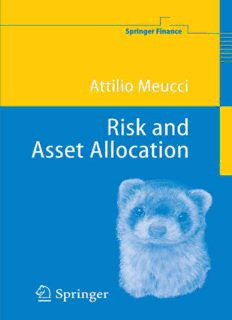
Risk and asset allocation PDF
Preview Risk and asset allocation
Springer Finance EditorialBoard M.Avellaneda G.Barone-Adesi M.Broadie M.H.A.Davis E.Derman C.Klüppelberg E.Kopp W.Schachermayer Springer Finance SpringerFinanceisaprogrammeofbooksaimedatstudents,academics andpractitionersworkingonincreasinglytechnicalapproachestothe analysisoffinancialmarkets.Itaimstocoveravarietyoftopics,notonly mathematicalfinancebutforeignexchanges,termstructure,risk management,portfoliotheory,equityderivatives,andfinancialeconomics. M.Ammann,CreditRiskValuation:Methods,Models,andApplication(2001) K.Back,ACourseinDerivativeSecurities:IntroductiontoTheoryand Computation(2005) E.Barucci,FinancialMarketsTheory.Equilibrium,EfficiencyandInformation(2003) T.R.BieleckiandM.Rutkowski,CreditRisk:Modeling,ValuationandHedging(2002) N.H.BinghamandR.Kiesel,Risk-NeutralValuation:PricingandHedgingofFinancial Derivatives(1998,2nded.2004) D.BrigoandF.Mercurio,InterestRateModels:TheoryandPractice(2001) R.Buff,UncertainVolatilityModels-TheoryandApplication(2002) R.A.DanaandM.Jeanblanc,FinancialMarketsinContinuousTime(2002) G.DeboeckandT.Kohonen(Editors),VisualExplorationsinFinancewith Self-OrganizingMaps(1998) R.J.ElliottandP.E.Kopp,MathematicsofFinancialMarkets(1999,2nded.2005) H.Geman,D.Madan,S.R.PliskaandT.Vorst(Editors),MathematicalFinance- BachelierCongress2000(2001) M.Gundlach,F.Lehrbass(Editors),CreditRisk+intheBankingIndustry(2004) B.P.Kellerhals,AssetPricing(2004) Y.-K.Kwok,MathematicalModelsofFinancialDerivatives(1998) M.Külpmann,IrrationalExuberanceReconsidered(2004) P.MalliavinandA.Thalmaier,StochasticCalculusofVariationsinMathematical Finance(2005) A.Meucci,RiskandAssetAllocation(2005) A.Pelsser,EfficientMethodsforValuingInterestRateDerivatives(2000) J.-L.Prigent,WeakConvergenceofFinancialMarkets(2003) B.Schmid,CreditRiskPricingModels(2004) S.E.Shreve,StochasticCalculusforFinanceI(2004) S.E.Shreve,StochasticCalculusforFinanceII(2004) M.Yor,ExponentialFunctionalsofBrownianMotionandRelatedProcesses(2001) R.Zagst,Interest-RateManagement(2002) Y.-L.Zhu,X.Wu,I.-L.Chern,DerivativeSecuritiesandDifferenceMethods(2004) A.Ziegler,IncompleteInformationandHeterogeneousBeliefsinContinuous-time Finance(2003) A.Ziegler,AGameTheoryAnalysisofOptions(2004) Attilio Meucci Risk and Asset Allocation With141Figures 123 AttilioMeucci LehmanBrothers,Inc. 745SeventhAvenue NewYork,NY10019 USA e-mail:attilio [email protected] MathematicsSubjectClassification(2000):15-xx,46-xx,62-xx,65-xx,90-xx JELClassification:C1,C3,C4,C5,C6,C8,G0,G1 LibraryofCongressControlNumber:2005922398 ISBN-10 3-540-22213-8 Springer-VerlagBerlinHeidelbergNewYork ISBN-13 978-3-540-22213-2 Springer-VerlagBerlinHeidelbergNewYork Thisworkissubjecttocopyright.Allrightsarereserved,whetherthewholeorpartofthematerial isconcerned,specificallytherightsoftranslation,reprinting,reuseofillustrations,recitation, broadcasting,reproductiononmicrofilmorinanyotherway,andstorageindatabanks. Duplicationofthispublicationorpartsthereofispermittedonlyundertheprovisionsofthe GermanCopyrightLawofSeptember9,1965,initscurrentversion,andpermissionforusemust alwaysbeobtainedfromSpringer-Verlag.ViolationsareliabletoprosecutionundertheGerman CopyrightLaw. SpringerisapartofSpringerScience+BusinessMedia springeronline.com ©Springer-VerlagBerlinHeidelberg2005 PrintedinTheNetherlands ScientificWorkPlace®isatrademarkofMacKichanSoftware,Inc.andisusedwithpermission. MATLAB®isatrademarkofTheMathWorks,Inc.andisusedwithpermission.TheMathWorks doesnotwarranttheaccuracyofthetextorexercisesinthisbook.Thisbook’suseordiscussionof MATLAB®softwareorrelatedproductsdoesnotconstituteendorsementorsponsorshipbyThe MathWorksofaparticularpedagogicalapproachorparticularuseoftheMATLAB®software. Theuseofgeneraldescriptivenames,registerednames,trademarks,etc.inthispublicationdoes notimply,evenintheabsenceofaspecificstatement,thatsuchnamesareexemptfromtherelevant protectivelawsandregulationsandthereforefreeforgeneraluse. Coverdesign:design&production,Heidelberg Coverillustration:courtesyofLindaGaylord Typesettingbytheauthor Printedonacid-freepaper 41/sz-543210 to my true love, should she come Contents Preface ....................................................XV Audience and style ......................................XVII Structure of the work ....................................XVIII A guided tour by means of a simplistic example .............XIX Acknowledgments .......................................XXVI Part I The statistics of asset allocation 1 Univariate statistics ....................................... 3 1.1 Building blocks.......................................... 3 1.2 Summary statistics ...................................... 9 1.2.1 Location ......................................... 9 1.2.2 Dispersion........................................ 11 1.2.3 Higher-order statistics ............................. 14 1.2.4 Graphical representations .......................... 15 1.3 Taxonomy of distributions................................ 16 1.3.1 Uniform distribution............................... 16 1.3.2 Normal distribution ............................... 18 1.3.3 Cauchy distribution ............................... 20 1.3.4 Student t distribution.............................. 22 1.3.5 Lognormal distribution............................. 24 1.3.6 Gamma distribution ............................... 26 1.3.7 Empirical distribution.............................. 28 1.T Technical appendix ......................................www 1.E Exercises . . . . ...... . .................................www 2 Multivariate statistics ..................................... 33 2.1 Building blocks.......................................... 34 2.2 Factorization of a distribution............................. 38 2.2.1 Marginal distribution .............................. 38 2.2.2 Copulas.......................................... 40 VIII Contents 2.3 Dependence............................................. 45 2.4 Shape summary statistics................................. 48 2.4.1 Location ......................................... 48 2.4.2 Dispersion........................................ 50 2.4.3 Location-dispersion ellipsoid ........................ 54 2.4.4 Higher-order statistics ............................. 57 2.5 Dependence summary statistics ........................... 59 2.5.1 Measures of dependence............................ 59 2.5.2 Measures of concordance ........................... 64 2.5.3 Correlation ....................................... 67 2.6 Taxonomy of distributions................................ 70 2.6.1 Uniform distribution............................... 70 2.6.2 Normal distribution ............................... 72 2.6.3 Student t distribution.............................. 77 2.6.4 Cauchy distribution ............................... 81 2.6.5 Log-distributions .................................. 82 2.6.6 Wishart distribution ............................... 84 2.6.7 Empirical distribution.............................. 87 2.6.8 Order statistics ................................... 89 2.7 Special classes of distributions ............................ 91 2.7.1 Elliptical distributions ............................. 91 2.7.2 Stable distributions................................ 96 2.7.3 In…nitely divisible distributions ..................... 98 2.T Technical appendix ......................................www 2.E Exercises . . . . ...... . .................................www 3 Modeling the market ......................................101 3.1 The quest for invariance..................................103 3.1.1 Equities, commodities, exchange rates................105 3.1.2 Fixed-income market ..............................109 3.1.3 Derivatives .......................................114 3.2 Projection of the invariants to the investment horizon........122 3.3 From invariants to market prices ..........................126 3.3.1 Raw securities ....................................126 3.3.2 Derivatives .......................................129 3.4 Dimension reduction .....................................131 3.4.1 Explicit factors....................................133 3.4.2 Hidden factors ....................................138 3.4.3 Explicit vs. hidden factors ..........................143 3.4.4 Notable examples .................................145 3.4.5 A useful routine...................................147 3.5 Case study: modeling the swap market .....................150 3.5.1 The market invariants .............................150 3.5.2 Dimension reduction...............................151 3.5.3 The invariants at the investment horizon .............160 3.5.4 From invariants to prices ...........................162 Contents IX 3.T Technical appendix ......................................www 3.E Exercises . . . . ...... . .................................www Part II Classical asset allocation 4 Estimating the distribution of the market invariants .......169 4.1 Estimators .............................................171 4.1.1 De…nition ........................................172 4.1.2 Evaluation .......................................173 4.2 Nonparametric estimators ................................178 4.2.1 Location, dispersion and hidden factors ..............181 4.2.2 Explicit factors....................................184 4.2.3 Kernel estimators .................................185 4.3 Maximum likelihood estimators ...........................186 4.3.1 Location, dispersion and hidden factors ..............190 4.3.2 Explicit factors....................................192 4.3.3 The normal case ..................................193 4.4 Shrinkage estimators.....................................200 4.4.1 Location .........................................201 4.4.2 Dispersion and hidden factors.......................204 4.4.3 Explicit factors....................................209 4.5 Robustness .............................................209 4.5.1 Measures of robustness.............................211 4.5.2 Robustness of previously introduced estimators........216 4.5.3 Robust estimators .................................221 4.6 Practical tips ...........................................223 4.6.1 Detection of outliers ...............................223 4.6.2 Missing data......................................229 4.6.3 Weighted estimates ................................232 4.6.4 Overlapping data..................................234 4.6.5 Zero-mean invariants ..............................234 4.6.6 Model-implied estimation...........................235 4.T Technical appendix ......................................www 4.E Exercises . . . . ...... . .................................www 5 Evaluating allocations .....................................237 5.1 Investor’s objectives .....................................239 5.2 Stochastic dominance ....................................243 5.3 Satisfaction.............................................249 5.4 Certainty-equivalent (expected utility) .....................260 5.4.1 Properties........................................262 5.4.2 Building utility functions...........................270 5.4.3 Explicit dependence on allocation ...................274 5.4.4 Sensitivity analysis ................................276 5.5 Quantile (value at risk) ..................................277 5.5.1 Properties........................................278 X Contents 5.5.2 Explicit dependence on allocation ...................282 5.5.3 Sensitivity analysis ................................285 5.6 Coherent indices (expected shortfall).......................287 5.6.1 Properties........................................288 5.6.2 Building coherent indices...........................292 5.6.3 Explicit dependence on allocation ...................296 5.6.4 Sensitivity analysis ................................298 5.T Technical appendix ......................................www 5.E Exercises . . . . ...... . .................................www 6 Optimizing allocations .....................................301 6.1 The general approach ....................................302 6.1.1 Collecting information on the investor................303 6.1.2 Collecting information on the market ................305 6.1.3 Computing the optimal allocation ...................306 6.2 Constrained optimization.................................311 6.2.1 Positive orthants: linear programming................313 6.2.2 Ice-cream cones: second-order cone programming ......313 6.2.3 Semide…nite cones: semide…nite programming .........315 6.3 The mean-variance approach..............................315 6.3.1 The geometry of allocation optimization..............316 6.3.2 Dimension reduction: the mean-variance framework....319 6.3.3 Setting up the mean-variance optimization............320 6.3.4 Mean-variance in terms of returns ...................323 6.4 Analytical solutions of the mean-variance problem ...........326 6.4.1 E¢cient frontier with a¢ne constraints...............327 6.4.2 E¢cient frontier with linear constraints ..............330 6.4.3 E¤ects of correlations and other parameters ..........332 6.4.4 E¤ects of the market dimension .....................335 6.5 Pitfalls of the mean-variance framework ....................336 6.5.1 MV as an approximation ...........................336 6.5.2 MV as an index of satisfaction ......................338 6.5.3 Quadratic programming and dual formulation.........340 6.5.4 MV on returns: estimation versus optimization........342 6.5.5 MV on returns: investment at di¤erent horizons .......343 6.6 Total-return versus benchmark allocation...................347 6.7 Case study: allocation in stocks ...........................354 6.7.1 Collecting information on the investor................355 6.7.2 Collecting information on the market ................355 6.7.3 Computing the optimal allocation ...................357 6.T Technical appendix ......................................www 6.E Exercises . . . . ...... . .................................www
Description: